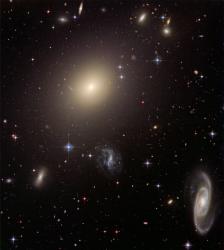 This beautiful picture is of a distant collection of galaxies called the Abell S0740 galaxy cluster, captured by the Hubble Space Telescope. It’s located more than 450 million light years away in the constellation Centaurus.
This beautiful picture is of a distant collection of galaxies called the Abell S0740 galaxy cluster, captured by the Hubble Space Telescope. It’s located more than 450 million light years away in the constellation Centaurus.
Continue reading “Distant Cluster of Galaxies Viewed by Hubble”
Hubble Sees An Extrasolar Planet’s Atmosphere
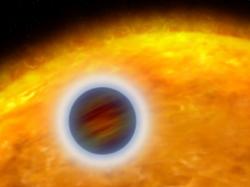 Now here’s a feat. The Hubble Space Telescope was able to analyze the atmosphere of a gas giant planet orbiting another star.
Now here’s a feat. The Hubble Space Telescope was able to analyze the atmosphere of a gas giant planet orbiting another star.
Continue reading “Hubble Sees An Extrasolar Planet’s Atmosphere”
Hubble’s Main Camera is Offline, Maybe Permanently
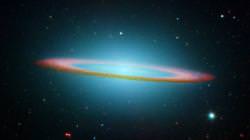 One of the Hubble Space Telescope’s main science instruments, the Advanced Camera for Surveys (ACS) has gone offline, and the chances of getting back online don’t look so good.
One of the Hubble Space Telescope’s main science instruments, the Advanced Camera for Surveys (ACS) has gone offline, and the chances of getting back online don’t look so good.
Continue reading “Hubble’s Main Camera is Offline, Maybe Permanently”
Hubble Sees a Hypergiant Star Nearing Death
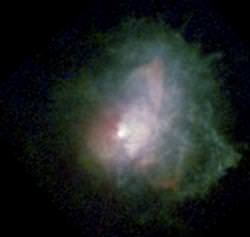 VY Canis Majoris, located about 5,000 light-years away, is no ordinary star; it’s a supergiant, containing 30 to 40 times the mass of our own Sun. And it’s so luminous it’s also considered a hypergiant, shining 500,000 times as bright as the Sun. And it’s big… really big. If this star lived in our Solar System, its surface would extend out to the orbit of Saturn.
VY Canis Majoris, located about 5,000 light-years away, is no ordinary star; it’s a supergiant, containing 30 to 40 times the mass of our own Sun. And it’s so luminous it’s also considered a hypergiant, shining 500,000 times as bright as the Sun. And it’s big… really big. If this star lived in our Solar System, its surface would extend out to the orbit of Saturn.
Continue reading “Hubble Sees a Hypergiant Star Nearing Death”
Hubble Helps Make a 3-D Map of Dark Matter
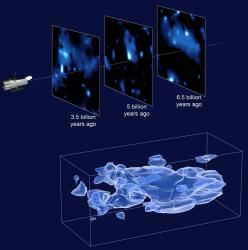 A team of astronomers has created a three-dimensional map of dark matter distribution across the Universe. This map gives some of the best evidence that normal matter, like you and me, stars and planets, accumulate around the densest regions of dark matter.
A team of astronomers has created a three-dimensional map of dark matter distribution across the Universe. This map gives some of the best evidence that normal matter, like you and me, stars and planets, accumulate around the densest regions of dark matter.
Continue reading “Hubble Helps Make a 3-D Map of Dark Matter”
Happy Hubble Holidays
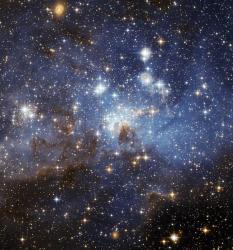 The fine folks at the Hubble Space Telescope released this photograph today to celebrate the holidays. I’m not sure which holiday specifically, but anytime is a good time to release beautiful new photographs from Hubble.
The fine folks at the Hubble Space Telescope released this photograph today to celebrate the holidays. I’m not sure which holiday specifically, but anytime is a good time to release beautiful new photographs from Hubble.
Continue reading “Happy Hubble Holidays”
Heavy Stars Embedded in NGC 6357
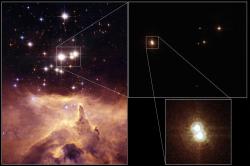 This Hubble photograph shows star cluster Pismis 24, which lies at the heart of emission nebula NGC 6357. The stars are some of the most massive ever seen in our galaxy, each of which weighs at least 100 times the mass of our Sun. Astronomers originally thought it was two stars, each of which exceeded the theoretical limits on stellar size. Hubble discovered that it’s actually three stars, bringing the reality back in line with theory.
This Hubble photograph shows star cluster Pismis 24, which lies at the heart of emission nebula NGC 6357. The stars are some of the most massive ever seen in our galaxy, each of which weighs at least 100 times the mass of our Sun. Astronomers originally thought it was two stars, each of which exceeded the theoretical limits on stellar size. Hubble discovered that it’s actually three stars, bringing the reality back in line with theory.
Continue reading “Heavy Stars Embedded in NGC 6357”
Spitzer and Hubble View Orion
This beautiful photograph is of a region in the Orion Nebula called the Trapezium. It was taken by merging images together from two of the Great Observatories: Hubble and Spitzer. The swirls of green are ultraviolet and visible images revealed by Hubble, while the reds and oranges are infrared detected by Spitzer. At the heart of the photograph lurk 4 massive stars, each of which is 100,000 times brighter than our own Sun. The nebula is located about 1,500 light years from the Earth, and can be seen in small telescopes or binoculars.
Continue reading “Spitzer and Hubble View Orion”
Super-Supermassive Black Hole
The Hubble Space Telescope, the Chandra X-Ray Observatory, and the National Radio Astronomical Observatory teamed up to produce this composite image of galaxy cluster MS0735.6+7421, located about 2.5 billion light-years from Earth. The cluster contains dozens of galaxies held together by gravity. A truly supermassive black hole lurks at the heart of this cluster, containing more than a billion solar masses. The red areas are twin jets of material streaming away from the black hole.
Continue reading “Super-Supermassive Black Hole”
NASA is Go for Hubble Repair
Finally some good news for the Hubble Space Telescope. NASA announced a new space shuttle mission to repair and upgrade the aging space telescope. This fifth and final visit to Hubble is tentatively scheduled for Fall 2008. Astronauts will install two new instruments: the Cosmic Origins Spectrograph, which will help probe large-scale structures in the Universe, and the Wide Field Camera 3, a very sensitive instrument capable of seeing from infrared to ultraviolet wavelengths.
Continue reading “NASA is Go for Hubble Repair”
